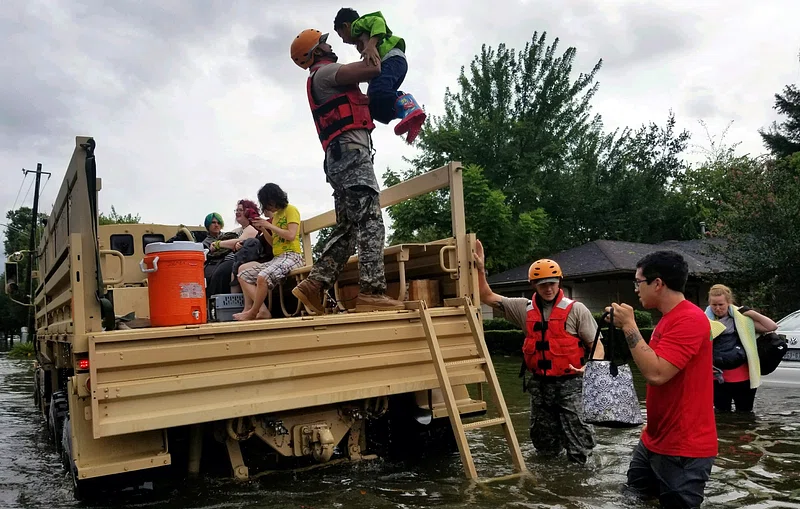On October 25, 2023, at 1:25 a.m. a massive typhoon, known as Hurricane Otis, hit Acapulco, Mexico. Otis originated from a disturbance several hundred miles south of the Gulf of Tehuantepec. The initial forecast expected the hurricane to only be a weak tropical storm, but instead, it underwent explosive intensification with winds that quickly increased by 115 miles per hour within 24 hours. The storm’s winds ended up blowing at a devastating 165 miles per hour to the shores near Acapulco, leaving the major tourist destination in southern Mexico entirely in ruins as well as completely decimating multiple infrastructures.
The lightning within the eye wall rapidly intensified as it approached the coast, but after reaching inland, the hurricane weakened before dissipating the following day. It received the highest category, specifically Category 5, for intensity level ever recorded for the large city. According to the National Hurricane Center, the tropical cyclone even surpassed Hurricane Patricia as the strongest Eastern Pacific hurricane to make landfall on record in the satellite era.
Reports and images from Acapulco showed the disastrous impairment that had been done to the area. Civilians had little time to prepare for the monstrous typhoon since communications had been heavily cut off by the storm, unfortunately making the event’s casualties increase. Descriptions from alternative sources who came to the scene described the aftermath of the catastrophic storm. The city had fatal damage to numerous establishments, as well as many high-rise buildings. According to the Mexican government’s preliminary damage assessment, the large hurricane impacted around “220,035 homes, and 80% of the area’s hotels were damaged.”
Heavy rains caused much flooding, and landslides and falling trees also resulted in multiple roadblocks, preventing people from being able to exit the city. Destruction was reported at “120 hospitals and clinics” NESDIS reported, and more than “10,000 utility poles were destroyed, knocking out power and internet/communications across the region.” Various transmission lines, electrical substations, and a power plant were also heavily damaged. This left information about the hurricane’s impact largely unknown.
When Otis originally hit, the government mobilized thousands of military members as quickly as possible to aid survivors and assist in recovery efforts. However, mudslides prevented crews from getting into the city to provide service to residents. As stated by the Associated Press, the “10,000 troops that were deployed to the area lacked the tools needed to clear mud and downed trees off roads.”
Though the commercial and military airports in Acapulco were significantly impaired, the U.S. Embassy & Consulates in Mexico stated that limited flights have been made available from the Acapulco International Airport to Mexico City on October 28.
As recovery operations continue, so does the widespread grief for families who suffered much loss due to this great crisis. Salgado Pineda said on Sunday that 340 people have been rescued by authorities, and the death/missing toll has significantly climbed to more than 100 residents. So far it has been reported that at least 45 people have been killed, but there are still 58 people currently missing. Fortunately, the Mexican Red Cross has commenced the process of delivering 75 tons of humanitarian aid to those who have been affected by the disaster.
It is rare to come upon a personal account in Livermore about a severe event such as this that occurred so far away. On Thursday, November 2, Elizabeth Corona, a Livermore resident, voiced her mother-in-law’s encounter with this horrific incident, “On Wednesday, October 25th, we found out that my husband’s mom, Eva Villalpando, who was in Mexico visiting family, had gone to Acapulco for a few days to go to the beach, and that a hurricane had gone through that night and no one could get ahold of her. The last time she had contact with family was Tuesday night at about 11:30 p.m. She had told the family that they had heard a tropical storm was coming, but they were only given about a two-hour notice that the storm had escalated to a category 5 hurricane. While on the phone, she said it was raining extremely hard and the winds were picking up. The living room had windows that ran the whole length of the wall and they had already shattered, as well as the windows in two of the three bedrooms. Then the power went out, and they lost all contact with her.
“We spent hours looking for updates online and on the news, but there wasn’t much information available. We were able to find videos that people had posted on X, which made us more worried because we were able to see just how bad the hurricane was. It wasn’t until approximately 11:45 p.m. on Thursday that my sister-in-law saw that Eva was reading the messages we had sent her on WhatsApp.
After 36 nerve-wracking hours, we had some hope that she was alive. We all began calling her cell phone. It would ring but then just end the call. It felt like an eternity, but she soon after called my husband’s phone. It was pure joy hearing her voice on the other end. Eva told us she felt like she was going to die. She said they had to push the furniture up against the bedroom door to keep it from blowing in.
“She said once the hurricane blew over, she and her brother and sister-in-law had to walk through knee-deep water to go to the store and buy food and water. All power was out in the city. She said debris was everywhere. She also said the store clerk was giving food for any price to whoever needed anything. Thankfully, Eva had told her brother-in-law to fill their gas tank up when they arrived in Acapulco. Once the road had dried up a little, they were able to drive out of town. It was truly a blessing that they were able to escape without any harm.”
NOAA satellites continue to monitor weather patterns, and tropical cyclone activity, and track the location, movement, and intensity of storms. Meteorologists and climate scientists have said that the warming of oceans and the impact of climate change might mean it is likely to see much more storm behavior in the future, so it’s important to be prepared and aware if you live in an area prone to extreme weather behavior.
Due to the chaotic storms and fatal destruction in Acapulco, fuel and supplies are still in extremely low stock, and electricity is unavailable for the entire city. Mexico officials said on Monday that they were working to hopefully restore the electricity in the area and to deliver fuel individually to families stuck there. The total structural damage from Hurricane Otis was estimated to be at least $1 billion dollars and will take a while to repair. In the meantime, all we can do is hope for the best and give support to all others who have not yet heard from their loved ones.
Footage released by X:
x.com/aviationbrk/status/1717890568947204400?s=10
x.com/volcaholic1/status/1719486372723990785?s=10
x.com/tallyman2023/status/1718149469647274100?s=10
x.com/schweikerc1191/status/1717093219731939580?s=10
x.com/unframedai/status/1717869417227292705?s=10





























